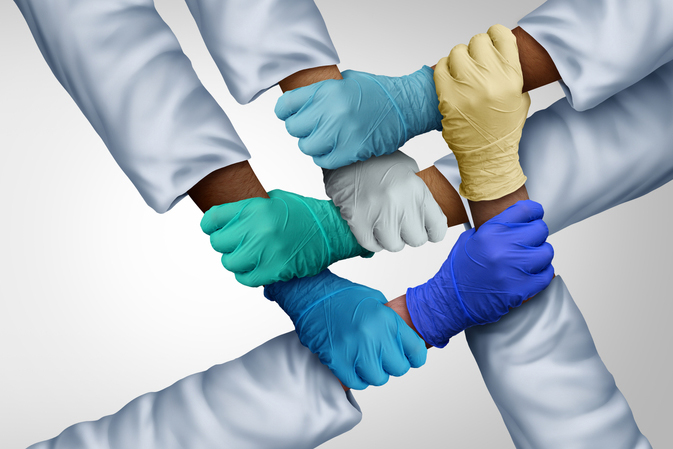An African proverb says that if you want to get somewhere fast, go alone, but if you want to go the distance, take a team. We say, why not do both?
Technology has allowed us to do more than ever before and increasingly from the comfort of our home office bubbles, but the journey of creating an exceptional culture is still about teamwork. And teamwork is all about being—and feeling—connected.
Teams can be made up of two people, a collective, or a small army. The commonality is connection, the bringing together of past, present, and even future experiences in order to deliver needed solutions.
The same principle applies to patients, doctors, and other healthcare stakeholders. Innovative online platforms, for example, can provide patients of all conditions with the ability to connect with mentors who have been through the same treatment, as well as directly connect with physicians across the nation—all in one place. These platforms leverage technology to break down the barriers that exist today in health care so patients can view the past, present, and future more clearly and ultimately make proactive and informed decisions for their own health.
Connecting with Employees and Creating an Exceptional Work Culture
A corporate culture that promotes health must be grounded in both a common mission and a common vision. These will connect everyone, regardless of their role in your company or even their level of involvement with your business. Managers should welcome direct and constructive feedback to help everyone improve. Anyone, at any level, should be made to feel comfortable giving and receiving feedback at any time. Feedback is an opportunity to give team members the resources they need to outperform. It is on every team member to ensure the team rises together and that every bit of feedback is treated as an opportunity to grow. The same should be true from the most entry-level employees all the way up to the executive team.
Ironically, founders and other company leaders may find it hardest to give feedback. We tend to be less certain about how our input from above will be received, but contrary to popular belief, feedback is sought and appreciated because it gives team members the opportunity to grow and improve.
Biweekly one-on-ones between employees and managers should be held for both personal and professional development. And every week, team members must connect with one another to ensure every single person feels comfortable, taken care of, and heard. The structure of these meetings is less important than ensuring that they take place. This may seem like overkill to some, but it ensures everyone has a voice. And connecting regularly recognizes each employee’s potential to develop quicker—and go farther—than he or she could alone.
Employee Benefits—More Is More!
For many companies, culture remains an abstract notion. Values should be emblazoned everywhere in plain sight. (We write ours on a wall paired with a white board on which our team members write down why they’re here and what they believe is important.) A healthy company culture should be dynamic, unique, and full of character—like a big family Thanksgiving dinner!
Being a health company implies an added level of individual awareness. We should provide benefits that help boost mental and physical health, like free fitness classes, relaxation credits for spa days, daily meals catered in the office, covered date nights with significant others, and team off-sites that inspire creativity. We need to develop intimate opportunities for learning, whether in person or via Zoom. I’ve found that all of these play an essential part in creating a culture of learning; professional development; and, most importantly, well-being.
After all, how can we support our clients if we don’t first support our own people? How can we call ourselves a care organization if we don’t take care of the people we work with every day?
Horizontal, Not Vertical
No matter how big a company gets, it should always remain primarily horizontal. This means that managers work next to the most junior employee on their team—and happily so! Easy access empowers and creates ownership for both the most senior managers and the newest hires. Regular, casual workweek outings across departments further promote collaboration and familiarization across every department of the organization. Of course, it’s challenging at the moment, but connecting outside of the walls of the office remains key.
Engagement to Development
We believe that all new hires should meet with everyone in the company within their first 2 weeks in casual settings that allow for the free flow of personalities. New people must be not only taught but also immersed in company procedures and systems, as well as new ways to approach critical thinking and problem-solving. After the first 2 weeks, team members should be constantly provided with educational resources and exposed to the top thinkers across different areas. For example, we have “work-late Wednesdays,” when everyone in the company stays late and works on moon-shot ideas. We also have thought leadership competitions in which winners get prizes ranging from a massage therapy session to new tech gear.
Many Teams, One Boat
Just like great health care, great company culture is nothing more than the people behind it—properly motivated and incentivized. An effective team, enabled by an innovative platform, works by helping each member earn his or her individual greatness. Your organization can—and should—move quickly, but all should know they’ll never go it alone.
Patrick Frank is the Cofounder and COO of PatientPartner, a health technology platform that is creating a new type of patient experience for those going through surgery. Frank has a degree in Finance from the University of San Diego and was recently named one of Forbes’s 30 Under 30 in Consumer Technology.

